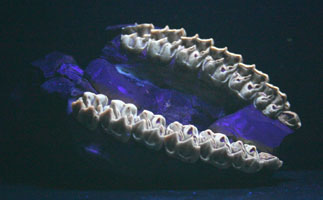Mesohippus bairdi was named by Othniel Marsh in 1875. Its common name is three toed horse. Mesohippus: Meso is Greek for middle and hippus for horse. Mesohippus was common in North America during the Middle Eocene to Early Oligocene (40 - 30 million years ago). It had longer legs than its predecessor, Eohippus. Its longer legs allowed it to flee predators like Hyaenodn and nimravids (false saber-toothed cats), but was often prey for those predators. It did manage to evolve while they went extinct.
It was a three toed horse, but predominantly stood on its middle toe. Its head and face was larger and longer than earlier horses. Its teeth were low crowned with a single gap behind the front teeth (this is where the bit now is placed in modern horses). It had a total of six grinding teeth on each side, top and bottom. Mesohippus browsed on tender twigs and fruit. Its cranial cavity was larger than its predecessors and similar to that of modern horses.
Because of replacement minerals, most of the fossil mammal teeth from the White River Formation of Nebraska will fluoresce to some degree. The teeth are usually replaced by calcite, which will fluoresce a yellow-white to yellow-orange. Any green showing up on the specimen is usually chalcedony and is usually part of the bone or bone marrow. On a few specimens there may be a bright green at the base of the specimen this will be an oil based clay holding up the specimen. Any purple on the specimen is the UV light reflecting off the light colored areas of the specimen and is not fluorescence. The fossil teeth from Nebraska will fluoresce under either long or short wave, but they fluoresce best under both at the same time. You may see a photo of some of the specimen under normal light or fluorescent light by returning to the main page and clicking on the link "to view specimen material from Nebraska." You may also view all teeth by going to the fossil teeth or fluorescent fossil teeth page and then to the appropriate page for the teeth you want to view. The item number will be the same as the number in the fluorescent section without the "F" at the end of the number.
Specimen is maxillary teeth. The first photo was taken under long wave ultraviolet light. The photo below was taken under short wave ultraviolet lighting.
Kingdom: Animalia, Phylum: Chordata, Class: Mammalia, Order: Perisodactyla, Family: Equidae, Sub-family: Anchitherinae, Genus: Mesohippus, Species: bairdi.
Horse - Mesohippus bairdi 
Quantity in Basket: None
Code: TNEH-101F
Price: $250.00
Shipping Weight: 0.92 pounds
Time: Early Eocene through Early Oligocene, approximately 40 - 30 million years ago.
Location: White River Formation, Brule Member, Harrison, Nebraska, USA
Dimensions: 4-3/8" x 3" x 2"